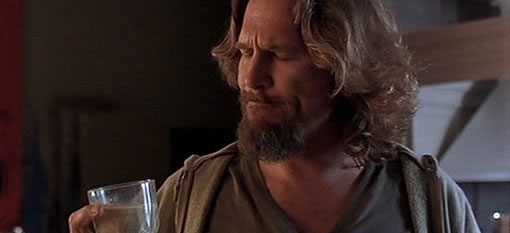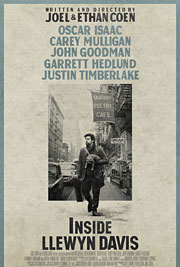Movie Review: “Hail, Caesar!”
Posted by David Medsker (02/04/2016 @ 11:00 am)
Josh Brolin, George Clooney, Scarlett Johansson, Tilda Swinton, Channing Tatum, Ralph Fiennes
Joel & Ethan Coen
For the first 20 minutes or so of “Hail, Caesar!,” it feels as though Joel and Ethan Coen are making another “Burn After Reading,” only this time their target is not political thrillers in particular, but ‘50s Hollywood in general. George Clooney’s character’s sword & sandals epic (and the movie’s namesake) is pompous beyond words, and Scarlett Johansson’s pool movie is disturbingly good at pointing out the continuity errors of those films (she’s bone-dry in every shot). Ultimately, though, “Hail, Caesar!” is not about the films at all, and once that becomes clear, the films within the film become a distraction. Amusing distractions, yes, but they’re sometimes hard to watch without thinking of things the movie could be doing instead that would make for a better overall viewing experience.
Eddie Mannix (Josh Brolin) is a “fixer” for the movie studio Capitol Pictures, where his day-to-day activities include making excuses for the whereabouts of his lothario superstar Baird Whitlock (Clooney), covering up a potential scandal involving his leading lady DeeAnna Morgan (Johansson), playing nice with the press (Tilda Swinton, playing twin reporters at rival publications), and executing the orders of the studio chief (whose last name, no joke, is Skank), no matter how boneheaded they may sound. Eddie soon discovers that Baird isn’t off on a bender, but has in fact been kidnapped, and is being held for $100,000 ransom. This all happens on the same day that Eddie is supposed to make a decision whether to leave Capitol for Lockheed Martin, a job with better hours and much better pay. He has a very short period of time to find a rat in an industry filled with rats.
Read the rest of this entry »
Movie Review: “Inside Llewyn Davis”
Posted by Jason Zingale (12/05/2013 @ 7:00 pm)
Oscar Isaac, Carey Mulligan, Justin Timberlake, John Goodman, Garrett Hedlund, Adam Driver
Joel & Ethan Coen
There aren’t many directors that can boast a track record as impressive as the one that Joel and Ethan Coen have enjoyed throughout their 30-year careers, and “Inside Llewyn Davis” is just another notch on that cinematic belt. Markedly different from a lot of their films in that it’s a much more intimate, character-driven piece, “Inside Llewyn Davis” most closely resembles “A Serious Man” in both tone and execution. But although the movie is a fairly bittersweet portrait of personal failure (a running theme in the Coens’ repertoire), it’s not without their trademark wit and humor. The comedy may not be as pronounced as in the duo’s other films, but it’s yet another fine period drama that showcases a different side of the directors.
Set during the early 1960s in the middle of the New York folk scene, the movie stars Oscar Isaac as Llewyn Davis, a struggling musician trying to make it as a solo artist after his former singing partner commits suicide. The music business is already difficult enough to break into, but even more so for the hard-to-market folk genre, despite Llewyn’s obvious talent. With no steady income or plans for the future, Llewyn spends his days wandering the city in search of his next gig and his nights crashing on friends’ couches, including musician couple Jean (Carey Mulligan) and Jim (Justin Timberlake), the former of whom Llewyn may or may not have gotten pregnant. Desperate to get out of town for a few days, Llewyn hitches a ride to Chicago to audition for legendary manager Bud Grossman (F. Murray Abraham).
Read the rest of this entry »
Hidden Netflix Gems: Raising Arizona
Posted by Nate Kreichman (02/02/2013 @ 9:00 am)
This week’s Hidden Netflix Gem: Raising Arizona (1987)

Even if you haven’t heard of Joel and Ethan Coen, you’ve sure as hell heard of some of their films. The brothers have jointly written, directed, and produced such modern classics as Fargo, The Big Lebowski, O Brother, Where Art Thou?, No Country for Old Men, and True Grit. Their work bounces around in time, space, and genre—the Coens never make the same movie twice—and they’ve been renowned for it over the past three decades, with 13 Academy Award nominations and four wins.
Before all those accolades, the Coen brothers made their debut with 1984’s Blood Simple, a neo-noir thriller. Not wanting to make a reputation as one-trick ponies, they avowed to make to their next project as different from their first as possible. Out of that desire, the one-of-a-kind screwball comedy Raising Arizona was born.
Our protagonist is Herbert I. “Hi” McDonnough, played by the polarizing Nicolas Cage, who can make or break a movie depending on whether or not he fits his character. Hi is the type of lovable nitwit that often fills Coen fare: an erudite idiot reminiscent of Lebowski’s Dude, if he’d been born in an Arizona trailer park and had a penchant (though not necessarily a skill) for robbing 24-hour convenience stores. Luckily, Cage slips into Hi’s skin masterfully, right down to the wacky hairdo and funny accent (“Temp-ee, Arizona”). The performance remains one of his best to date, although ultimately Adaptation takes the cake.
Opposite Cage is Holly Hunter as the tight-lipped policewoman, Edwina or “Ed,” who’s always taking the recidivist Hi’s mugshot photos. After one particularly fateful arrest, Hi finds Ed in tears and learns that her fiance has left her. He proposes after his latest release from prison, and the two get married and move into a tiny trailer in the Arizona desert, which Hi lovingly calls a “suburban starter home.” One of the film’s many sources of comedy is the contrast between the upbeat world of Hi’s narration and that of the more objective reality we see on screen.
Hi does his best to “stand up and fly straight” after settling into married life, getting a job in a machine shop, but finds it difficult “with that darned Reagan in the White House.” Nonetheless, as time passes, the couple want to take the logical next step and start a family. Unfortunately, “biology is against them,” as they receive the unhappy news that Edwina is “barren,” and they’re denied the chance to adopt because of Hi’s criminal record.
Read the rest of this entry »
Posted in: Entertainment, Movies
Tags: Coen Brothers, Ethan Coen, Hidden Netflix Gems, Hidden Netflix Gems Blog, Holly Hunter, Joel Coen, John Goodman, Nate Kreichman, Nicolas Cage, Raising Arizona, Staff Picks - Movies, William Forsythe
Drink of the Week: The White Russian
Posted by Bob Westal (08/12/2011 @ 5:00 pm)
 Cocktail classicists beware, because this week we’re saluting the immanent blu-ray release of the Coen Brothers’ comedy classic, “The Big Lebowski,” as well as the historic Lebowski Fest cast reunion with a drink that not only contains vodka but which usually requires no shaking and perhaps not even a great deal of stirring. That’s not all, the White Russian is extremely sweet and seems to derive not from the cocktail heights of the early 20th century but closer to the mixological nadir of the 1970s. The fact that it was a drink simple enough for a stoner to love led to it being immortalized on celluloid in the aforementioned 1998 film with Jeff Bridges, easily the greatest example of the pot-driven comedy genre yet made. Next to James Bond’s shaken vodka martini, the Dude’s Caucasian — same drink, different name — is easily the most legendary of all movie cocktails.
Cocktail classicists beware, because this week we’re saluting the immanent blu-ray release of the Coen Brothers’ comedy classic, “The Big Lebowski,” as well as the historic Lebowski Fest cast reunion with a drink that not only contains vodka but which usually requires no shaking and perhaps not even a great deal of stirring. That’s not all, the White Russian is extremely sweet and seems to derive not from the cocktail heights of the early 20th century but closer to the mixological nadir of the 1970s. The fact that it was a drink simple enough for a stoner to love led to it being immortalized on celluloid in the aforementioned 1998 film with Jeff Bridges, easily the greatest example of the pot-driven comedy genre yet made. Next to James Bond’s shaken vodka martini, the Dude’s Caucasian — same drink, different name — is easily the most legendary of all movie cocktails.
Still, no movie can make a drink popular all on its own, and the White Russian’s appeal is obvious; it tastes like a frozen candy bar. Moreover, the fact that it contains a bit of caffeine and even some rudimentary nutrition also makes it a highly appropriate beverage, not only for achievers but for caffeine heads like me. No wonder that it was one of the first cocktails I gravitated to in my ignorant youth and no wonder I still enjoy it when the time is right. Sometimes there’s no time for a martini and a very sweet cappuccino to follow it up. Impact-wise, the white Russian gives you a bit of both.
The White Russian
1.5 ounces vodka
3/4 ounces Kahlua or other coffee liqueur
3/4 ounces of heavy cream (or somewhat larger portions of half-and-half, whole milk, or even 2% milk)
Pour vodka and Kahlua over ice in rocks glass. Add heavy cream, which should “float” over the top, or other dairy topping. Stir and proceed to get into endless arguments with your friends about whether or not urinating on a rug constitutes a Saddam Hussein-like act of imperial aggression.
***
There are a number of variations on the above, of course. You can eschew the diary product and go for a black Russian. I understand that if you use 2% or lower fat content film it’s called a Skinny Russian, which isn’t awful. On the other hand, I can tell you first hand that going past half-and-half and into the land of heavy cream will make the drink all the more tasty, though perhaps not tasty enough to warrant the eventual heart attack if you drink these things on too regular a basis. On the other hand, if you’re drinking as many Caucasians as the Dude seems to do during the course of a single day, wear and tear on your heart may not be your primary concern.
Also, I have to note cocktail historian David Wondrich‘s recipe actually calls for the drink to be made in a shaker and strained into a chilled rocks glass. It’s not bad that way, though it’s hard to imagine the Dude putting in all that work. As Wondrich points out, this is a drink beloved both by very occasional drinkers like my former self for its sweet-as-ice-cream taste and for the most down and out of out-and-out alcoholics, for whom it’s often the closest thing they’ll get to a balanced meal. Yes, a White Russian is for all, but really it belongs to just one man.

Posted in: Food & Drink, Lifestyle
Tags: cocktails, Coen Brothers, David Wondrich, Drink of the Week, Happy Hour, Jeff Bridges, Kahlua, Lebowski Fest, Lebowski Fest cast reunion, Skinny Russian, The Big Lebowski, the White Russian, vodka, white Russian




 Cocktail
Cocktail 









